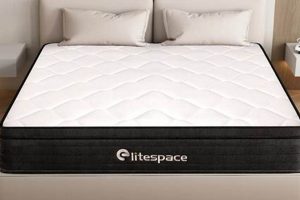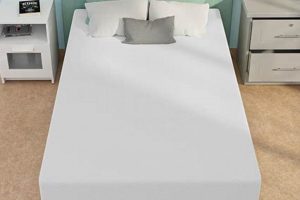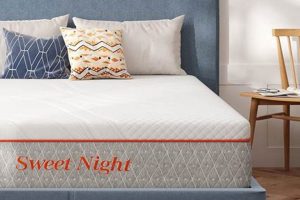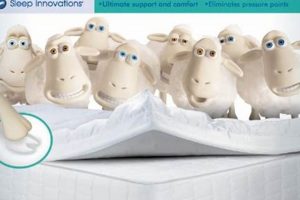A six-inch mattress represents an entry-level option in the realm of sleep surfaces, characterized by its reduced thickness and often lighter construction. These mattresses are typically composed of a core material like foam or innersprings, often covered with a basic fabric layer. They offer a firm sleep experience and are generally suited for individuals with lower body weights or as temporary sleeping solutions.
The importance of considering thinner mattresses lies in their affordability, portability, and suitability for specific applications. These types of mattresses are commonly used in bunk beds, daybeds, guest rooms, and camping environments. Their reduced weight and size facilitate easier transport and storage. Historically, thinner mattresses were prevalent before advancements in materials and manufacturing allowed for thicker, more elaborate designs.
This article will delve into factors influencing the selection of a suitable six-inch mattress, including material composition, firmness levels, target user profiles, and value propositions. Analysis of different construction types and their impact on support, comfort, and longevity will be provided. Furthermore, guidance on evaluating these attributes in relation to individual needs and preferences will be presented.
Tips for Selecting a Six-Inch Mattress
Choosing a six-inch mattress requires careful consideration due to its limited thickness. Prioritize factors that directly impact comfort and support given the inherent constraints of this mattress type.
Tip 1: Assess Intended Use: Determine the primary purpose. For infrequent use in a guest room, a basic foam model may suffice. For regular use, consider a hybrid design with a thin coil layer for enhanced support.
Tip 2: Evaluate Sleeper Weight: Lighter individuals will generally find six-inch mattresses more comfortable. Individuals with higher body weights may experience insufficient support and should explore thicker alternatives.
Tip 3: Examine Core Material: Foam density influences firmness and durability. Higher-density foams offer greater support and resist compression over time. Innerspring units should be examined for coil gauge and distribution.
Tip 4: Consider Edge Support: Limited thickness often translates to reduced edge support. Evaluate edge firmness, particularly if the mattress will be used near its perimeter or by individuals who tend to sleep close to the edge.
Tip 5: Analyze Firmness Level: Six-inch mattresses are typically firmer. Consider personal preference and sleeping position. Side sleepers may require a softer surface to alleviate pressure points, while back and stomach sleepers may prefer the added support.
Tip 6: Check for Certifications: Look for certifications such as CertiPUR-US, which indicate the foam has been tested for harmful chemicals and emissions. This promotes healthier sleep and environmental responsibility.
Tip 7: Review Warranty and Return Policies: Understand the manufacturer’s warranty and return policy. This provides recourse in case of defects or dissatisfaction with the mattress’s performance.
Selecting a six-inch mattress involves a balance of affordability and functionality. By carefully assessing intended use, sleeper weight, core material, firmness, and certifications, a suitable choice can be made.
The subsequent sections will provide a detailed comparison of different six-inch mattress models and their suitability for various sleep needs and budgets.
1. Firmness Level
Firmness level is a crucial consideration when evaluating a six-inch mattress due to its direct impact on comfort, support, and overall sleep quality. The limited thickness necessitates a careful selection to compensate for the reduced material depth and ensure adequate support for the sleeper.
- Spinal Alignment
The firmness of a six-inch mattress directly affects spinal alignment. A mattress that is too soft may allow the sleeper to sink too deeply, leading to spinal misalignment and potential back pain. Conversely, a mattress that is too firm may not conform to the body’s natural curves, creating pressure points and discomfort. The appropriate firmness level maintains the spine’s natural curvature during sleep, promoting proper alignment and reducing the risk of musculoskeletal issues.
- Pressure Relief
Firmness influences pressure relief, particularly for side sleepers. A mattress that is too firm may exert excessive pressure on the hips and shoulders, leading to discomfort and potential joint pain. A slightly softer surface allows for greater contouring to the body’s shape, distributing weight more evenly and reducing pressure on sensitive areas. However, excessive softness can compromise support and spinal alignment.
- Sleeper Weight and Position
Optimal firmness is influenced by sleeper weight and preferred sleeping position. Lighter individuals may find a firmer six-inch mattress tolerable, while heavier individuals typically require a firmer surface to prevent excessive sinking. Side sleepers generally benefit from a slightly softer mattress for pressure relief, while back and stomach sleepers often prefer a firmer surface for improved spinal support.
- Material Composition
The materials used in a six-inch mattress can greatly affect the perceived firmness. A six-inch mattress made of high-density foam will feel much firmer compared to a six-inch mattress made with softer, low-density foam. The arrangement of support coils also affect the overall firmness of the mattress.
Therefore, when considering a six-inch mattress, the firmness level must be carefully assessed in relation to individual body weight, sleeping position, and preferences for comfort and support. The ideal firmness ensures proper spinal alignment, adequate pressure relief, and a comfortable sleep experience despite the mattress’s limited thickness.
2. Material Quality
Material quality is paramount when evaluating a six-inch mattress, given its direct correlation to durability, comfort, and overall sleep experience. The limited thickness accentuates the significance of selecting high-quality materials that compensate for the reduced material volume and maintain structural integrity.
- Foam Density and Composition
Foam density is a key indicator of a six-inch mattress’s longevity and support. Higher-density foams resist compression and sagging over time, ensuring consistent support and preventing premature degradation. The foam’s composition, such as memory foam or high-resilience foam, influences its ability to conform to the body, relieve pressure points, and regulate temperature. Inferior foams may break down quickly, leading to discomfort and reduced lifespan. The “best” six-inch mattress typically utilizes high-density, CertiPUR-US certified foam.
- Coil Gauge and Count (If Applicable)
If the six-inch mattress incorporates innersprings, the coil gauge and coil count become critical. A lower coil gauge indicates thicker, more durable coils that provide firmer support. A higher coil count generally translates to better weight distribution and reduced motion transfer. Low-quality coils may be prone to bending, breaking, or uneven support, compromising the mattress’s structural integrity and potentially causing discomfort. The innerspring system in a “best” six-inch mattress features a robust coil system to provide optimal support.
- Fabric Cover Durability and Breathability
The fabric cover of a six-inch mattress plays a role in both comfort and longevity. A durable, tightly woven fabric protects the inner materials from wear and tear, extending the mattress’s lifespan. Breathable fabrics promote airflow, preventing heat buildup and maintaining a comfortable sleep environment. Flimsy or non-breathable fabrics can lead to premature wear, overheating, and discomfort. A high-quality, breathable cover is indicative of a well-constructed, comfortable six-inch mattress and a good indicator of the overall quality.
- Adhesive Quality and Construction
The adhesive used to bond the different layers of a six-inch mattress impacts its overall durability and stability. High-quality adhesives ensure the layers remain securely bonded, preventing shifting, bunching, or delamination over time. Poorly applied or low-quality adhesives can lead to premature breakdown of the mattress, compromising its structural integrity and comfort. A “best” six-inch mattress relies on high-quality adhesives and proper construction techniques.
In summary, material quality directly impacts a six-inch mattress’s longevity, comfort, and support. Selecting a mattress with high-density foams, durable coils (if applicable), breathable fabrics, and reliable adhesives ensures a longer-lasting, more comfortable, and supportive sleep surface, making it a key factor in determining its overall value and suitability.
3. Support Structure
The support structure within a six-inch mattress is critically important, given the limited available thickness to provide adequate postural support and prevent premature sagging. Its design and composition directly influence the mattress’s ability to maintain spinal alignment and distribute weight effectively.
- Core Material Composition and Density
The primary component providing support in a six-inch mattress is typically a foam core or, less commonly, a thin innerspring system. High-density foam provides greater resistance to compression, translating to firmer support and reduced long-term sagging. Conversely, lower-density foams offer minimal support and are more susceptible to degradation. In mattresses incorporating innersprings, the gauge and configuration of the coils determine the level of support and motion isolation. A six-inch mattress using high-density foam or a well-configured innerspring system will offer a more robust support structure.
- Zoning and Targeted Support
Zoning refers to the incorporation of different densities or types of materials within the mattress to provide targeted support to specific areas of the body. For example, firmer foam may be used in the center third of the mattress to support the lumbar region, while softer foam may be used in the shoulder and hip areas to alleviate pressure points. Zoning is less common in six-inch mattresses due to their limited thickness but can significantly enhance comfort and spinal alignment when implemented effectively. Mattresses with zoned support can minimize pressure points that cause sleep disruptions.
- Edge Support Systems
Edge support refers to the reinforcement of the mattress’s perimeter to prevent sagging and provide a stable sleeping surface across the entire mattress. This is particularly important for individuals who sleep near the edge or sit on the edge of the bed. In six-inch mattresses, edge support is typically achieved through the use of higher-density foam encasements or strategically placed coils along the perimeter. Inadequate edge support can lead to a feeling of instability and reduced usable sleeping surface.
- Foundation Compatibility
The type of foundation used with a six-inch mattress can significantly impact its perceived support and longevity. A solid, supportive foundation, such as a platform bed or a box spring in good condition, will provide a stable base and prevent sagging. Conversely, a flexible or worn-out foundation can exacerbate any weaknesses in the mattress’s support structure and accelerate its degradation. Choosing a compatible foundation is crucial for maximizing the lifespan and performance of a six-inch mattress.
Ultimately, the effectiveness of the support structure in a six-inch mattress determines its ability to promote proper spinal alignment, distribute weight evenly, and resist sagging over time. Mattresses with a robust support system, whether through high-density foam, strategically placed coils, zoning, or appropriate edge support, generally offer a more comfortable and supportive sleep experience. Matching the mattress with a proper foundation is crucial to the life span of the mattress.
4. Weight Capacity
Weight capacity is a fundamental consideration when evaluating any mattress, but it assumes particular significance in the context of a six-inch mattress. The inherent limitations in thickness necessitate careful attention to ensure the mattress can adequately support the intended user(s) without compromising its structural integrity or long-term performance. Exceeding the weight capacity will lead to premature sagging, reduced support, and a significantly shortened lifespan.
- Impact on Support and Sagging
A six-inch mattress designed for a specific weight range provides optimal support and minimizes the risk of sagging. Overloading the mattress beyond its stated capacity causes excessive compression of the core materials, leading to uneven support and potential spinal misalignment. Sagging not only diminishes comfort but also accelerates the mattress’s deterioration. For example, a six-inch foam mattress intended for individuals under 200 pounds will exhibit premature sagging and reduced support if consistently used by someone weighing 250 pounds.
- Material Compression and Durability
Weight capacity directly influences the rate of material compression within a six-inch mattress. Exceeding the limit forces the foam or innerspring components to compress beyond their intended range, leading to irreversible damage and reduced resilience. This is particularly relevant for thinner mattresses, where the limited material volume offers less resistance to compression. Consequently, the mattress’s lifespan is significantly shortened, requiring premature replacement. The “best” six-inch mattress is chosen to match a certain weight capacity to last for years.
- Influence on Comfort and Pressure Relief
Proper weight distribution is essential for comfort and pressure relief. When a six-inch mattress is overloaded, the sleeper may experience localized pressure points, particularly in the hips and shoulders. The reduced material thickness offers limited cushioning, making it more difficult for the mattress to conform to the body’s contours and distribute weight evenly. This can result in discomfort, restlessness, and potential joint pain. The correct weight distribution allows for optimal pressure points to be balanced during sleep.
- Warranty Implications
Many mattress warranties explicitly state weight capacity limitations. Exceeding the specified weight limit often voids the warranty, leaving the consumer responsible for any damages or premature wear. This underscores the importance of carefully selecting a six-inch mattress that is appropriately rated for the intended user(s) to ensure continued coverage against manufacturing defects or premature sagging. Carefully reading the fine print is an imperative step in securing the longevity of a mattress.
In conclusion, weight capacity is a critical determinant of a six-inch mattress’s performance, durability, and warranty coverage. Selecting a mattress that is appropriately rated for the intended user(s) is essential for maximizing its lifespan, maintaining proper support, and ensuring a comfortable sleep experience. Neglecting weight capacity considerations can lead to premature sagging, reduced comfort, and voided warranty coverage, ultimately diminishing the mattress’s value and necessitating premature replacement.
5. Price Point
Price point is a significant factor in the consideration of a six-inch mattress due to its inherent limitations. The limited material volume typically translates to lower manufacturing costs, resulting in a generally lower price point compared to thicker mattresses. However, the pursuit of the absolute lowest price can often lead to compromises in material quality and construction, directly impacting the mattress’s support, durability, and overall lifespan. The “best” six-inch mattress necessitates a balance between affordability and quality, requiring consumers to carefully evaluate the value proposition offered at a specific price point.
For instance, a six-inch mattress priced significantly below the average market range may utilize low-density foam or a minimal innerspring system, resulting in inadequate support and premature sagging. Conversely, a higher-priced six-inch mattress may incorporate higher-density foam, enhanced edge support, or a more durable fabric cover, justifying the increased cost with improved performance and longevity. Retailers often offer budget-friendly options that compromise long-term value for initial cost savings. The relationship between price and features must be assessed carefully. Practical applications include comparing specifications and warranty information across different price tiers to determine the most suitable option for individual needs and budget constraints.
In summary, price point is an integral component of the overall value proposition of a six-inch mattress. While affordability is a primary driver for many consumers, it is essential to recognize the potential trade-offs in material quality and construction associated with lower prices. By carefully assessing the specifications, warranty, and construction details at various price points, consumers can make an informed decision that balances cost considerations with the need for adequate support, durability, and comfort. The challenge lies in identifying the “best” six-inch mattress that provides the optimal balance between price and performance, ensuring a reasonable lifespan and satisfactory sleep experience. This is dependent on matching the quality and price to the user.
6. Durability Rating
Durability rating is a critical factor when evaluating a six-inch mattress. Given its limited thickness, the materials and construction directly impact its ability to withstand long-term use. A high durability rating signifies a longer lifespan and consistent performance over time, factors often associated with the “best 6 inch mattress”.
- Foam Density and Compression Resistance
Foam density, measured in pounds per cubic foot (PCF), is a primary indicator of durability. Higher-density foams resist compression and maintain their shape over prolonged use. A six-inch mattress with a high PCF rating is less likely to sag or develop impressions, extending its usable lifespan. For example, a mattress with a 2.0 PCF density will generally outlast one with a 1.5 PCF density, contributing to a higher durability rating and thus being considered a “best” option. This is especially true of mattresses constructed entirely of foam.
- Innerspring Coil Gauge and Tempered Steel
For six-inch mattresses utilizing innersprings, the coil gauge and steel tempering are critical. Lower gauge numbers indicate thicker, more durable coils that are less prone to bending or breaking. Tempered steel undergoes a heating and cooling process to increase its strength and resilience. A six-inch mattress with lower-gauge, tempered steel coils will offer greater support and a longer lifespan, positively impacting its durability rating. This contrasts with thinner, non-tempered coils that may quickly lose their shape and effectiveness.
- Fabric Cover Abrasion Resistance
The fabric cover’s ability to withstand abrasion and wear is a key aspect of durability. A tightly woven, high-quality fabric is less likely to tear, pill, or degrade over time. Abrasion resistance is often measured using the Wyzenbeek test, with higher numbers indicating greater durability. A six-inch mattress with a cover that scores well on abrasion tests will maintain its appearance and structural integrity for a longer period, contributing to a higher durability rating and user satisfaction. Quality fabric is often overlooked but critical to longevity.
- Construction Techniques and Seam Strength
The methods used to assemble the mattress and the strength of the seams contribute significantly to its overall durability. Reinforced seams and meticulous construction techniques prevent premature separation of the layers and ensure the mattress maintains its shape. A six-inch mattress with robust seams and careful construction will be less prone to sagging or shifting, resulting in a higher durability rating. This is often reflected in the warranty offered by the manufacturer, with longer warranties indicating greater confidence in the product’s longevity.
The durability rating of a six-inch mattress is a composite measure of its ability to withstand wear and tear over time. High-density foams, robust innersprings (if applicable), abrasion-resistant fabrics, and meticulous construction techniques all contribute to a higher rating, making the mattress a more reliable and long-lasting investment. Consumers seeking a “best 6 inch mattress” should prioritize these factors to ensure they select a product that will provide consistent support and comfort for years to come.
7. Certifications
Certifications play a crucial role in determining the quality and safety of a six-inch mattress, and are therefore an important criterion for identifying a “best 6 inch mattress.” These certifications often indicate adherence to specific standards related to material composition, emissions, and durability. For example, CertiPUR-US certification ensures that the foam used in the mattress has been tested for harmful chemicals, volatile organic compounds (VOCs), and ozone depleters. The presence of such certifications provides assurance that the mattress meets established safety and environmental standards.
Furthermore, certifications can relate to the mattress’s construction and performance. Certifications like OEKO-TEX Standard 100 ensure that the textile components of the mattress are free from harmful substances. Certain certifications may also assess the mattress’s durability and resistance to wear and tear, providing an indication of its long-term performance. Real-life examples include mattresses marketed as “hypoallergenic” often carrying certifications from organizations specializing in allergen control. These certifications demonstrate that the mattress has undergone testing and meets specific criteria for reducing allergen exposure.
In conclusion, certifications serve as valuable indicators of a six-inch mattress’s quality, safety, and performance. While the presence of a certification does not automatically guarantee that a mattress is superior, it provides a level of assurance that the product has undergone testing and meets certain standards. Therefore, consumers seeking the “best 6 inch mattress” should carefully consider certifications as part of their evaluation process, weighing their importance alongside other factors such as material composition, support structure, and price. Ignoring certifications can expose buyers to products with substandard materials and unsafe chemicals.
Frequently Asked Questions About Six-Inch Mattresses
The following questions and answers address common inquiries and concerns regarding six-inch mattresses. This information aims to provide clarity and assist in making informed purchasing decisions.
Question 1: Are six-inch mattresses suitable for everyday use?
The suitability of a six-inch mattress for daily use depends on several factors, including the sleeper’s weight, sleeping position, and personal preferences. Lighter individuals may find adequate support, while heavier individuals may require a thicker mattress for optimal comfort and spinal alignment. Individuals with chronic back pain or specific orthopedic concerns should consult with a healthcare professional to determine the appropriate mattress thickness.
Question 2: What is the typical lifespan of a six-inch mattress?
The lifespan of a six-inch mattress varies based on material quality, usage patterns, and sleeper weight. Generally, a six-inch mattress can be expected to last between 3 to 5 years with proper care and maintenance. Mattresses constructed with higher-density foams and robust innerspring systems (if applicable) tend to exhibit greater durability and a longer lifespan. Regular rotation and the use of a protective mattress cover can help extend the mattress’s usable life.
Question 3: Can a six-inch mattress adequately support a heavier individual?
Six-inch mattresses are generally not recommended for individuals exceeding 200 pounds. The limited thickness often results in insufficient support and premature sagging, leading to discomfort and potential spinal misalignment. Heavier individuals should consider mattresses with greater thickness and higher density support cores to ensure adequate support and long-term durability.
Question 4: What types of bed frames or foundations are compatible with a six-inch mattress?
Six-inch mattresses are compatible with a wide range of bed frames and foundations, including platform beds, slatted frames, and box springs. It is essential to ensure that the chosen foundation provides adequate support and is in good condition. A worn-out or sagging foundation can negatively impact the mattress’s performance and lifespan. Solid platform beds generally offer the most stable and supportive base for thinner mattresses.
Question 5: Are there any specific cleaning or maintenance requirements for a six-inch mattress?
Regular cleaning and maintenance can help extend the lifespan and maintain the hygiene of a six-inch mattress. Vacuuming the mattress regularly removes dust mites and allergens. Spot cleaning spills immediately prevents staining and bacterial growth. Rotating the mattress every few months promotes even wear. The use of a waterproof mattress protector safeguards the mattress from spills and moisture damage.
Question 6: What are the common signs that a six-inch mattress needs to be replaced?
Common signs that a six-inch mattress requires replacement include visible sagging, persistent impressions, uneven support, increased discomfort, and the development of allergens or odors. If the mattress no longer provides adequate support or contributes to sleep disturbances, it is advisable to consider a replacement. Ignoring these signs can lead to chronic pain and sleep deprivation.
This section provided answers to some frequently asked questions related to six-inch mattresses. Carefully evaluating individual needs and preferences is crucial when selecting a mattress. The information presented here aims to assist in making informed choices that align with individual requirements and promote restful sleep.
In the upcoming sections, the content will transition to a conclusion summarizing the key points discussed.
Concluding Remarks on Six-Inch Mattresses
The preceding discussion has provided a detailed examination of the attributes and considerations relevant to selecting a six-inch mattress. Material quality, support structure, weight capacity, price point, durability rating, and certifications have been identified as critical determinants of performance and longevity. Determining which model represents the best 6 inch mattress for a given individual hinges on a thorough assessment of these factors in relation to specific needs and preferences.
Prospective purchasers are urged to weigh the presented information carefully to align their selection with realistic expectations and budget constraints. While affordability may be a primary concern, compromising on fundamental aspects of support and durability can lead to premature replacement and diminished sleep quality. The long-term value of a six-inch mattress is intrinsically linked to its ability to provide adequate support and withstand the rigors of regular use. Informed decision-making remains paramount in optimizing sleep health and maximizing investment return.







![Best 7 Inch Mattress [Guide] - Cheap & Comfortable! Organic & Natural Mattress Buyer’s Guide: Non-Toxic Sleep Solutions Best 7 Inch Mattress [Guide] - Cheap & Comfortable! | Organic & Natural Mattress Buyer’s Guide: Non-Toxic Sleep Solutions](https://mattressworldpa.com/wp-content/uploads/2025/07/th-3700-300x200.jpg)